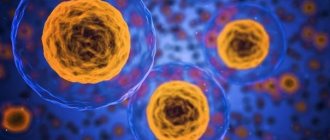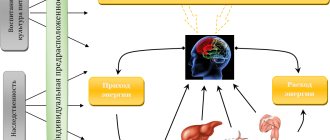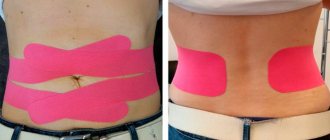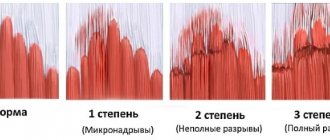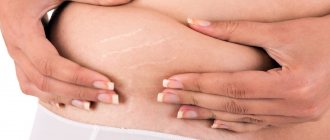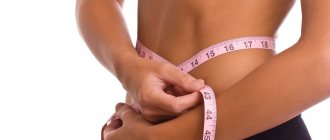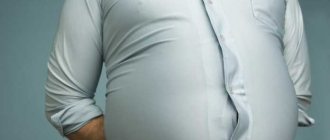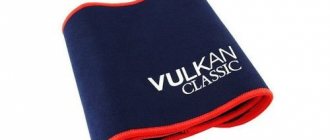Degrees of abdominal deformation Indications and contraindications for panniculectomy Preparation Progress of the operation Results and rehabilitation period
The adipose apron is a large excess of skin and fat localized on the anterior abdominal wall. It is characterized by pronounced ptosis (drooping) of soft tissues. It is not only an aesthetic defect. If the skin-fat fold sags to the level of the hips, diaper rash, irritation, itching occur, weeping ulcers can form, an unpleasant odor appears, and there is a high risk of eczema.
Most often, the problem of the appearance of an apron is faced by people (both women and men equally) who have lost significant weight or those whose weight often fluctuates in one direction or another - this causes deformation of the abdominal muscles. In women, such a defect can be provoked by pregnancy: while carrying a child, the rectus abdominis muscles may separate, which will cause prolapse of the anterior abdominal wall.
You can’t get rid of sagging skin with diets and exercises. The problem can only be solved with the help of panniculectomy - a surgical operation to remove the abdominal apron (its name comes from the Latin word pannus - “apron”).
Panniculectomy is the only method of combating ptosis of the skin-fat structure. For example, liposuction is a way to simply pump out fat. In addition, panniculectomy should not be confused with abdominoplasty. The latter involves not only removing fat and skin, but also lifting muscles. When correcting the apron, you can combine these types of plastic surgery.
Degrees of abdominal deformation
Before surgically removing excess skin and fat tissue, the plastic surgeon assesses the degree of abdominal deformation. The more pronounced the changes, the more difficult the operation will be.
| Deformation degree | To what level does the skin-fat apron reach? |
| I | Pubic hairline |
| II | External genitalia |
| III | Upper thigh |
| IV | Mid thigh |
| V | Knees |
Types of abdominoplasty
Belly fat folds can be removed using several methods. For a young patient who wants to remove excess skin in the abdominal area and an older woman who is dissatisfied with a voluminous “apron,” different abdominoplasty methods are performed:
- Partial – removal of excess skin on the anterior abdominal wall. The operation has virtually no complications, as it involves minimal incisions;
- Classic – eliminates excess subcutaneous fat in the abdominal area. The muscle tissue is sutured and tightened, forming a new flat abs. Extended - removes excess skin and fat not only on the stomach, but also on the thighs. In case of hernial formations, herniotomy is performed.
To achieve better results, abdominoplasty is often combined with liposuction. This allows you to get the perfect belly and improve the contour of your entire body.
Indications and contraindications for panniculectomy
The indication for the procedure is the presence of a skin-fat apron. It is important that the patient’s weight is stabilized before the intervention. If further weight loss is planned, the problem may return, and the effect of the operation will disappear.
Panniculectomy is a traumatic and complex operation, so there are many contraindications to it. Intervention is not carried out in the following cases:
- hypertension;
- infectious diseases;
- chronic diseases in the acute stage;
- blood clotting disorder;
- obesity;
- diabetes mellitus and other diseases of the endocrine system;
- oncology;
- autoimmune diseases;
- problems with the cardiovascular system;
- liver and kidney failure;
- any diseases of internal organs.
Abdominoplasty result
Abdominoplasty is not a surgical procedure for the treatment of obesity and weight loss. Abdominal plastic surgery does not help with visceral fat. Patients who are severely overweight need to lose weight before undergoing tummy tuck surgery. Weight loss after abdominoplasty can lead to the formation of new, sagging excess skin.
As a rule, the result of abdominoplasty remains for life. The operation eliminates the hanging belly (the skin-fat “apron” in the lower abdomen) and normalizes the proportions of the figure.
The formation of postoperative scars occurs over a period of 8 months to a year. The surgeon makes some incisions along natural folds, making them less noticeable. If necessary, laser resurfacing of scars is possible.
Preparation
Long before surgery, the patient should stabilize his weight and improve his overall health. For several months before surgical removal of the abdomen, you need to adhere to a low-calorie diet plan, food should be rich in microelements and vitamins. In addition to the diet, it is recommended to engage in physical exercise to strengthen the muscle frame.
For 2 weeks, you must stop smoking, alcoholic beverages, blood thinners and contraceptives that cause blood clots.
Nicotine impedes the healing process, and the presence of alcohol in the blood reduces its coagulability. These factors have a major impact when planning such a complex and large-scale intervention.
7-10 days before the operation, you need to undergo an examination: take blood and urine tests, do an ECG and fluorography, as well as other studies as prescribed by the doctor. The patient should consult with an anesthesiologist and therapist.
On the day of surgery, you cannot use decorative and skincare cosmetics; women need to remove nail polish. It is necessary to carry out hygiene procedures and remove hair in the area of the operation.
Progress of the operation
Panniculectomy is performed under general anesthesia. Its duration can reach 8 hours, depending on the complexity and scale of the manipulations.
Typically, two incisions are made:
- horizontal (in the pubic area, from which excess skin and adipose tissue is removed);
- vertical (from the lower border of the sternum to the pubic bone).
After removing the skin-fat apron, the boundaries of the incisions are sutured layer by layer, and a drainage tube is installed.
Diastasis (divergence) of the rectus abdominis muscles can be eliminated at the same time.
Operation “Remove the apron on the stomach”
How to remove a fat apron? First of all, before planning plastic surgery, it is important to understand that no conservative measures (diet, sports, bandages) can eliminate your problem. Only in this case can the operation be planned.
How to remove belly fat and get lasting results? You need to be at a comfortable weight: you cannot adjust your stomach during the weight loss stage, the result will be short-lived and less predictable.
Preparation
Preparation for surgery to remove the fat apron begins at least two weeks before it. It is highly advisable for patients to quit smoking, not drink alcohol, and not take medications that thin the blood - all this will help avoid possible complications. It is also necessary to undergo a very thorough examination, since abdominoplasty is a rather serious intervention and a large burden on the patient’s body, including the use of anesthesia.
Despite the different methods of performing abdominoplasty, the general principle is still the same: the skin-fat apron is removed under general anesthesia.
It is possible to remove the apron on the stomach after childbirth no earlier than 6-9 months after childbirth, when physical activity and diet do not help. But we must not forget about the lactation process: it is not recommended to carry out the operation until it is completed.
- Methods for correcting belly fat:
- A full abdominoplasty involves the upper, middle, and lower parts of the abdomen. During the operation, one incision is made - along the bikini line (later it will be hidden behind the line of underwear), and the navel is removed separately. Then the skin and subcutaneous fat are separated from the abdominal wall, and the doctor begins the correction. Excess skin and fat will be removed. Then the aponeurosis of the abdominal muscles is tightened and stitched using non-absorbable threads. If necessary, the navel is moved or modeled. The final stage of the operation is the installation of subcutaneous drainage (which is used to remove wound discharge) and the application of external sutures, and then bandages and compression garments.
The peculiarity of abdominoplasty in our clinic is not in the technique (it is standard all over the world), but in the method of suturing and, most importantly, in the quality of the suture material.
- Mini abdominoplasty, when removing abdominal fat, requires only one incision along the bikini line, but the incision is smaller than with a full abdominoplasty. Excess skin and fat are also removed and tightened. The “mini” option is used when there is no obvious excess tissue above the navel, and this is rare. No matter how the name of the operation may seem more “gentle,” this is the same serious procedure as a full abdominoplasty. It requires the same careful preparation. The only thing is that the rehabilitation period is a little shorter. The patient is unlikely to be able to decide on his own whether to undergo full or mini plastic surgery. In any case, the doctor will always honestly say when mini-abdominoplasty will give results, and when it will be a pointless attempt to avoid unnecessary trauma.
Many people are interested in the question: is it possible to remove the apron on the stomach using endoscopic abdominoplasty? The answer is clear - no. The skin-fat apron refers to the presence of excess skin and fat that cannot be removed without incisions. Endoscopic technique involves tightening the aponeurosis and removing hernias through punctures.
It is possible to remove the abdominal apron surgically, the main thing is that the operation is performed by an experienced surgeon.
Results and rehabilitation period
The operation allows you to completely remove the apron and give the figure a beautiful outline. The patient becomes slim and fit. The achieved result must be maintained by constantly monitoring your weight, eating right, and regularly performing moderate exercise. The scars from the incisions will turn white within a year and stop protruding above the skin, but will not disappear completely. They can be polished with a laser. On the 3-4th day after surgery, the drainage tube is removed.
In the first days, the patient is in the hospital because he requires effective pain relief and frequent dressing changes.
After returning home you need for 1-2 months:
- ensure peace of mind;
- minimize any physical activity;
- do not lift heavy objects (over 4 kg);
- wear a bandage or compression garment for 2 months (or another period recommended by your doctor) to stabilize the result.
In addition, during the recovery period the following is prohibited:
- overheat the intervention area - go to the bathhouse, sauna, take a hot bath;
- visit a public swimming pool;
- sunbathing - both under the sun and in a solarium;
- overeat.
The doctor may additionally prescribe physical therapy to speed up recovery and improve the quality of the skin in the intervention area.
To prevent complications, the doctor prescribes a course of antibiotics. In addition, each patient is recommended a course of treatment for dysbiosis, which can be caused by antibiotics.
When a noticeable fold forms on the stomach, which is called an “apron,” a person experiences complexes and discomfort. A panniculectomy can help, during which not only excess skin is removed, but also fat deposits.
Gvaramiya Eka Yurievna
Participant of congresses, conferences and seminars on plastic surgery. Priority areas: abdominoplasty, blepharoplasty, liposuction, reconstructive plastic surgery.
Methods for removing skin-fat apron
There are various technologies for performing abdominoplasty; before performing them, it is necessary to undergo an extensive medical examination to determine contraindications. The essence of abdominoplasty is to peel away the front part of the peritoneal wall and move it lower, while excess fat and skin are removed. Before suturing the wound, silicone drains are installed to ensure timely drainage of fluid, after which continuous skin sutures are installed in layers.
The following methods for removing skin-fat deformation are distinguished:
- Dermatolipectomy (panniculectomy) is an operation that makes it possible to eliminate excess skin and fat. It consists of dissecting the skin-fat fold in the abdominal area and can be combined with herniotomy and hysterectomy;
- Liposuction is the limited removal of fat through minor punctures using a cannula;
- Local abdominoplasty is an operation in the lower abdomen, which is performed without transferring the navel. This type of abdominoplasty is used to eliminate minor aesthetic defects and stretch marks that appear during pregnancy;
- Extended abdominoplasty is a technology for removing skin and fat deformation, which requires relocation of the navel, which helps to give a natural and harmonious appearance to the abdomen. Extended abdominoplasty is prescribed when the defect reaches a large size and if it is necessary to completely correct the tissues of the abdominal wall;
- Mini abdominoplasty is a surgical intervention that involves cutting excess skin in the anterior peritoneum area and does not involve transferring the navel. In most cases, mini abdominoplasty is combined with liposuction.

